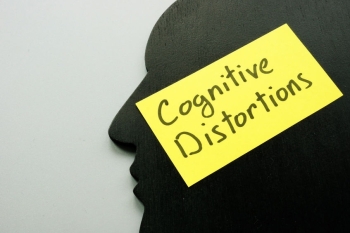
Social Anxiety Treatment in Philadelphia: A major component of social anxiety is thinking others are judging or testing you, thinking you will embarrass yourself, thinking you are inadequate compared to the others you are interacting with, etc. These thoughts also can also feel excessive or out of control. These automatic negative thoughts that people with social anxiety experience can set themselves up for negative social interactions. The more someone is in their head with their negative thoughts, the less they are in the moment, and the less able they are to respond to a situation appropriately. The disconnect that occurs fuels social anxiety, making it more likely that the person will have a negative social interaction. This reinforces the social anxiety, thus creating a vicious cycle.
One of the most important aspects of overcoming social anxiety is to challenge automatic negative thoughts, which can often also be called “cognitive distortions”. Cognitive distortions are unrealistic, inaccurate or exaggerated thoughts that fuel our negative thoughts and beliefs about ourselves. We all use cognitive distortions to some degree, but they are problematic when they become the dominant way of thinking. The key to dealing with cognitive distortions is to become more aware of when you are using them, so you can positively and realistically reframe these cognitive distortions. When you correct the distortions in the moment, you have successfully broken the cycle, thus beginning the process of change. Common cognitive distortions include: filtering, black & white thinking, personalization, overgeneralizing, disqualifying the positive, catastrophizing, mind reading, should statements, fortune telling & emotional reasoning:
- Filtering: When the positive feedback you hear from others or positive aspects of a situation are disregarded and you focus only on the negative.
- Black and White Thinking: When there is no room for gray—or middle ground. Things are either all right, or all wrong, all good or all bad. Also known as all or nothing thinking.
- Personalization: Attributing yourself as the reason for a negative event in which you were not responsible for.
- Overgeneralizing: When you take a single experience and come to a broad conclusion.
- Disqualifying the Positive: Disregarding any positive feedback or experiences. Making up reasons why these positive experiences are not legitimate or do not matter.
- Catastrophizing: Exaggerating or minimizing the importance of certain events or feedback to fit your negative beliefs.
- Mind Reading: When you believe that others are thinking about you negatively but do not have any evidence and do not seek out evidence.
- Should Statements: Telling yourself you “should,” “must,” and “ought to” which can be limiting and create unrealistic expectations.
- Fortune Telling: Anticipating that things will absolutely end badly.
- Emotional Reasoning: Believing that your negative emotions or beliefs are true.
Let’s look at an example of a real life situation and how some of these cognitive distortions might play out in someone who has social anxiety. Rob has social anxiety, as well as low self-esteem. Rob is invited to a dinner with several friends. At dinner his friend Sarah congratulates him on a job promotion he recently got. Then Sarah starts talking with another friend, Adam. Rob feels upset and then sits at the table, choosing to withdrawl from the conversation, hoping that Sarah will notice and pull him into the conversation.
In the above example, if Rob had believed Sarah was sincere in her congratulations, he might have joined the conversation or if he trusted their friendship, he would not have taken her decision to speak with someone else personally. In the end, Rob’s s thought process about the situation leaves him isolated and stuck with his own ruminations. Rob’s cognitive distortions about this situation might be…
- “Sarah really doesn’t care I got the promotion, she’d rather talk to Adam.” [Filtering]
- “Sarah is such a bad friend.” [Black and White Thinking]
- “I am such a bore that I forced Sarah to talk to Adam.” [Personalization]
- “I must be the most uninteresting person here.” [Overgeneralizing]
- “Sarah only congratulated me about the promotion to be nice. She doesn’t really think I deserve it.” [Disqualifying the Positive]
- “No one cares about my promotion.” [Catastrophizing]
- “I know Adam is probably talking to her about how lame I am.” [Mind Reading]
- “I should have other people talking to me right now instead of sitting alone.” [Should Statements]
- “If this is how the dinner started, then the rest of the night is going to suck.” [Fortune Telling]
- “I feel socially awkward, so I must be socially awkward.” [Emotional Reasoning]
Now that you are familiar with the different cognitive distortions take a few minutes and ask yourself which ones come most naturally to you. Everyone, even “super healthy” people engage in cognitive distortions sometimes. The real issue with cognitive distortions is the degree to which we engage in them. For people that engage in congitive distortions often, it is worthwhile to change this pattern. If you recognize that you could benefit from engaging in cognitive distortions less often, the next step is to reframe your cognitive distortions when they occur.
Reframing means to counter or correct your cognitive distortion to a positive, or at least realistic statement. This can be hard to do in the moment when you experience a cognitive distortion. Start to record your cognitive distortions and then either in the moment, or later when you have time, write your reframed statement. Remember, the statement should be at least realistic, if not positive. Try to be lawyer-like, and argue against the voice of your cognitive distortions. Once you get used to reframing you will be more able to reframe in the moment. Reframing will also help you to be more present because it will challenge you to examine what is actually happening during the interaction, versus what is going on in your head. The more present you can be, the more likely you will be able to feel engaged in the interaction. Likely the more engaged you feel, the more positively you will feel about the interaction.
Using the example of Rob, examine the reframes for each cognitive distortion below:
Cognitive Distortion:
“Sarah really doesn’t care I got the promotion, she’d rather talk to Adam.” [Filtering]
Reframe:
“Sarah showed she cared by congratulating me. Her talking to Adam does not discredit this.”
Cognitive Distortion:
“Sarah is such a bad friend.” [Black and White Thinking]
Reframe:
“Just because Sarah is talking to another person does not make her a bad friend. She has proved time after time just how good of a friend she really is.”
Cognitive Distortion:
“I am such a bore that I forced Sarah to talk to Adam.” [Personalization]
Reframe:
“We are at a dinner with all of our friends. Its completely normal to try and talk with others—it does not mean I am boring.”
Cognitive Distortion:
“I must be the most uninteresting person here.” [Overgeneralizing]
Reframe:
“I might not be the most interesting person here, but I am probably not the most uninteresting.”
Cognitive Distortion:
“Sarah only congratulated me about the promotion to be nice. She doesn’t really think I deserve it.” [Disqualifying the Positive]
Reframe:
“Sarah took the time to congratulate me. She seemed extremely happy that I got the promotion.”
Cognitive Distortion:
“No one cares about my promotion.” [Catastrophizing]
Reframe:
“I have not even made the effort to tell many people about my promotion. Maybe if I told people, people would care. The people that do know, have congratulated me.”
Cognitive Distortion:
“I know Adam is probably talking to her about how lame I am.” [Mind Reading]
Reframe:
“I have zero evidence that Adam is even talking about me. If I want to find out I could just simply walk over and join their conversation.”
Cognitive Distortion:
“I should have other people talking to me right now instead of sitting alone.” [Should Statements]
Reframe:
“I could make the effort to go over and talk to others and then I will not be sitting alone.”
Cognitive Distortion:
“If this is how the dinner started, then the rest of the night is going to suck.” [Fortune Telling]
Reframe:
“I do not know how the rest of the night will go, but I should make an effort to make it fun instead of thinking it will go badly.”
Cognitive Distortion:
“I feel socially awkward, so I must be socially awkward.” [Emotional Reasoning]
Reframe:
“Just because I feel socially awkward, does not mean I am socially awkward. I have not had any feedback tonight about coming off that way to others.”
Remember…You will need to challenge your cognitive distortions over a long period of time to experience a decrease or to feel like they do not have as much power over you. Be patient with yourself. Also keep in mind that this is only one of many strategies to cope with social anxiety. Therefore, if you find this strategy does not work for you, do not get discouraged because there are other strategies available to you. However, keep working at reframing, just to see if you need more practice with this technique. Generally this gets easier over time. If after several weeks you are still struggling, contact The Center for Growth / Social Anxiety Treatment in Philadelphia and speak to a counselor today.

























